OCIMF-防海盗手册介绍
- 格式:pdf
- 大小:859.53 KB
- 文档页数:37
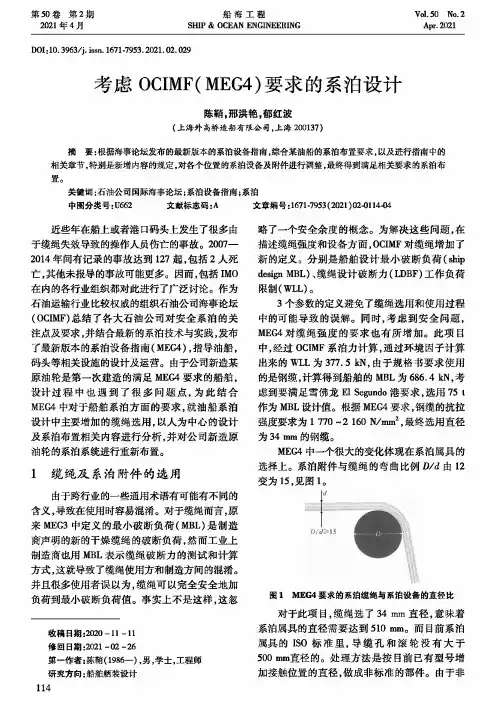
Vol. 50 No. 2Apr. 2021第50卷第2期2021年4月船海工程SHIP & OCEAN ENGINEERING DOI : 10.3963/j. issn. 1671-7953.2021.02.029考虑OCIMF(MEG4)要求的系泊设计陈鞘,邢洪艳,郁红波(上海外高桥造船有限公司,上海200137)摘要:根据海事论坛发布的最新版本的系泊设备指南,综合某油船的系泊布置要求,以及进行指南中的 相关章节,特别是新增内容的规定,对各个位置的系泊设备及附件进行调整,最终得到满足相关要求的系泊布 置。
关键词:石油公司国际海事论坛;系泊设备指南;系泊中图分类号:U662 文献标志码:A 文章编号:1671-7953 (2021)02-0114-04近些年在船上或者港口码头上发生了很多由 于缆绳失效导致的操作人员伤亡的事故。
2007-2014年间有记录的事故达到127起,包括2人死亡,其他未报导的事故可能更多。
因而,包括IMO 在内的各行业组织都对此进行了广泛讨论。
作为石油运输行业比较权威的组织石油公司海事论坛(OCIMF)总结了各大石油公司对安全系泊的关注点及要求,并结合最新的系泊技术与实践,发布了最新版本的系泊设备指南(MEG4),指导油船,码头等相关设施的设计及运营。
由于公司新造某 原油轮是第一次建造的满足MEG4要求的船舶,设计过程中也遇到了很多问题点,为此结合MEG4中对于船舶系泊方面的要求,就油船系泊设计中主要增加的缆绳选用,以人为中心的设计及系泊布置相关内容进行分析,并对公司新造原油轮的系泊系统进行重新布置。
1 缆绳及系泊附件的选用由于跨行业的一些通用术语有可能有不同的含义,导致在使用时容易混淆。
对于缆绳而言,原 来MEG3中定义的最小破断负荷(MBL)是制造 商声明的新的干燥缆绳的破断负荷,然而工业上制造商也用MBL 表示缆绳破断力的测试和计算方式,这就导致了缆绳使用方和制造方间的混淆。
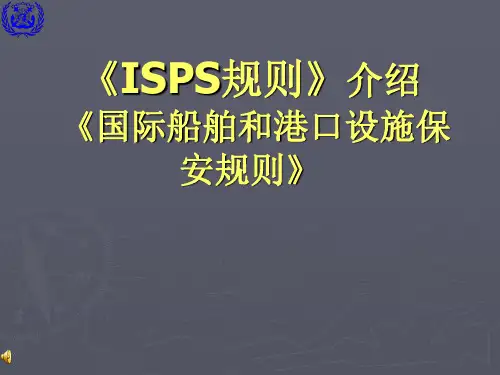
![关于船舶防海盗工作的措施建议[修改版]](https://uimg.taocdn.com/200300ff05a1b0717fd5360cba1aa81144318fa0.webp)
第一篇:关于船舶防海盗工作的措施建议关于船舶防海盗工作的措施建议1 海盗活动的主要区域和活动特点印尼水域:劫持船舶,持械抢劫,偷、抢财物等都曾有发生。
其中,主要是偷、抢船舶备件、工具、救生筏、缆绳、油漆、钢丝等物品。
海盗团伙一般选择在船员交接班、下大雨等时机潜入船舶,迅速搬走救生筏、缆绳等物,或潜藏起来观察船员值班情况,择机进入机舱或物料间行窃。
2 防海盗工作的基本方针2.1 坚持“以人为本”,确保船员安全。
船舶防海盗工作应坚持“以人为本”的原则,在确保船员安全的前提下尽全力保护财产安全,万一船舶被海盗控制,要掌握与海盗周旋及谈判技巧保证船员生命安全。
多数海盗分子登船的目的是偷盗财物,当偷窃活动被船员发现时,为得到财物海盗可能袭击船员。
船员不论当班与否,一旦发现海盗在船,应与其保持安全距离,立即报告驾驶台,驾驶台应立即拉响警铃,通知全体船员集合驱赶海盗,切勿单独行动,以防被其所伤。
如发现海盗在仓库、个人房间等封闭场所行窃,切勿单独入内驱赶海盗,应报警呼叫其他船员协助驱赶。
2.2 坚持“以防为主”的方针,尽量远离岸边航行。
船舶计划在海盗活动频繁的海区航行,设计航线时尽量远离岸边,航行中在驾驶台保持足够人员进行正规瞭望,防止可疑小船驶近本船,航行期间,如有其他船舶要求本船停车即接受检查时,船长千万不要轻易停车,有事待抵港后再说。
2.3 “拒海盗于船舷以外”,不给海盗上船机会。
在海盗活动海区航行或锚泊,应加强值班。
如发现可疑小船驶近本船,应采用灯光照射,声响威慑、甲板皮龙水喷撒等手段迫使小船远离本船。
当发现海盗企图登船时,要用水柱喷射海盗,设法切断海盗的登船设施。
2.4 集体行动,迫使海盗离船。
发现海盗登船时,应及时启动船上的警铃,全体船员立即到指定地点集合,形成威慑力,迫使海盗知难而退。
2.5 妥善安排急救,确保船员安全。
一旦有船员被海盗袭击受伤,船长应认真评估船员的伤势,及时报告公司,妥善急救,尽快安排送岸治疗。
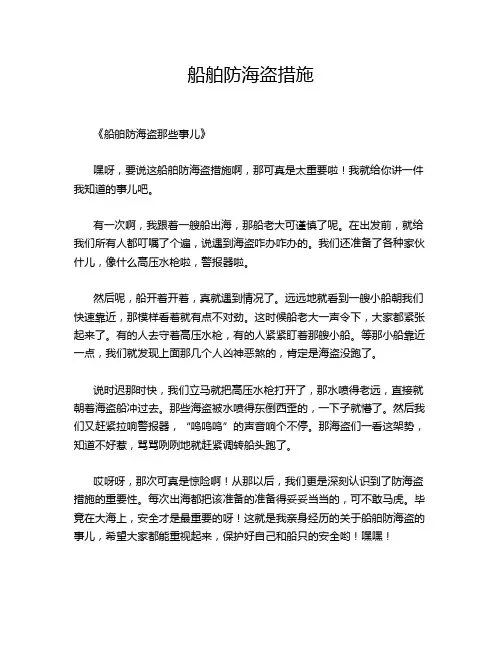
船舶防海盗措施
《船舶防海盗那些事儿》
嘿呀,要说这船舶防海盗措施啊,那可真是太重要啦!我就给你讲一件我知道的事儿吧。
有一次啊,我跟着一艘船出海,那船老大可谨慎了呢。
在出发前,就给我们所有人都叮嘱了个遍,说遇到海盗咋办咋办的。
我们还准备了各种家伙什儿,像什么高压水枪啦,警报器啦。
然后呢,船开着开着,真就遇到情况了。
远远地就看到一艘小船朝我们快速靠近,那模样看着就有点不对劲。
这时候船老大一声令下,大家都紧张起来了。
有的人去守着高压水枪,有的人紧紧盯着那艘小船。
等那小船靠近一点,我们就发现上面那几个人凶神恶煞的,肯定是海盗没跑了。
说时迟那时快,我们立马就把高压水枪打开了,那水喷得老远,直接就朝着海盗船冲过去。
那些海盗被水喷得东倒西歪的,一下子就懵了。
然后我们又赶紧拉响警报器,“呜呜呜”的声音响个不停。
那海盗们一看这架势,知道不好惹,骂骂咧咧地就赶紧调转船头跑了。
哎呀呀,那次可真是惊险啊!从那以后,我们更是深刻认识到了防海盗措施的重要性。
每次出海都把该准备的准备得妥妥当当的,可不敢马虎。
毕竟在大海上,安全才是最重要的呀!这就是我亲身经历的关于船舶防海盗的事儿,希望大家都能重视起来,保护好自己和船只的安全哟!嘿嘿!。
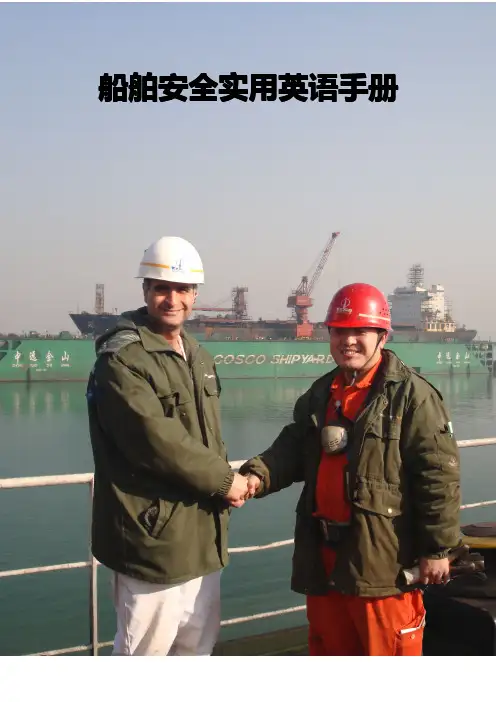
船舶安全实用英语手册本手册旨在提高公司安全人员与船方人员(外籍)沟通和交流的能力,把实际工作中涉及的交际用语和专业术语结合起来,以日常对话的形式成文。
本手册共可分为两大部分:一部分是工作性质的交流对话,涉及船舶进场、VSCC会议、作业审批、发现船方问题的处理、环境保护、消防与应急管理等六大章节;另一部分是常用句子和词汇的速查,对业务类型进行分门别类,以便于使用者在工作中的快速查找。
虽然内容并不十分详尽,但也不失为一本实用性较强的口袋型手册。
本手册的编写过程中,注重与实际工作的紧密结合,且涵盖了多方面的作业和安全措施,但难免有所疏漏,还希望使用者能多提宝贵意见,以便手册的不断完善。
第一课船舶进厂第二课VSCC(单船安全协调委员会)会议第三课作业审批第四课发现船方问题的处理第五课环境保护第六课消防与应急管理附录A常用句子附录B常用词汇附录C船方与厂方组织机构第一课船舶进厂SRM——总管(王先生)SUP——机务(格林先生)SS——安全主管(康先生)CP——船长C/E——轮机长C/O——大副SRM:Good morning,Mr.Green!SRM:早上好!格林先生。
SUP:Good morning,Mr.Wang!SUP:早上好!王先生。
SRM:Welcome to our shipyard!Please allow me to introduce our members who are in charge of this work:Commercial Manager-Mr.Zhang, Safety Supervisor-Mr.Kang,Hull Supervisor-Mr.Li,Machinery Supervisor-Mr.Ma,Painting Supervisor-Mr.Ge,Staging Supervisor-Mr.Zheng,Electrical Supervisor-Mr.Wu,Quality Supervisor-Mr.Yang,Technical Supervisor-Mr.Liu.SRM:欢迎来到我们船厂!请允许我介绍一下我们这项工作的管理人员:经营代表张先生,安全主管康先生,船体主管李先生,轮机主管马先生,涂装主管葛先生,脚手架主管郑先生,电气主管吴先生,质检主管杨先生,技术主管刘先生。
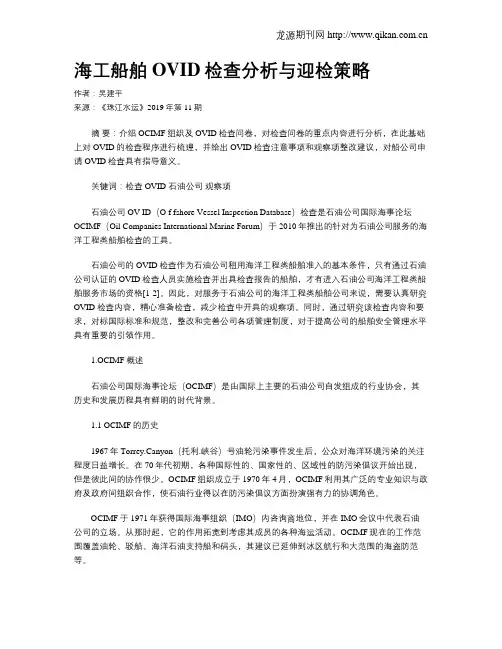
海工船舶OVID检查分析与迎检策略作者:吴建平来源:《珠江水运》2019年第11期摘要:介绍OCIMF组织及OVID检查问卷,对检查问卷的重点内容进行分析,在此基础上对OVID的检查程序进行梳理,并给出OVID检查注意事项和观察项整改建议,对船公司申请OVID检查具有指导意义。
关键词:检查 OVID 石油公司观察项石油公司OV ID(O f fshore Vessel Inspection Database)检查是石油公司国际海事论坛OCIMF(Oil Companies International Marine Forum)于2010年推出的针对为石油公司服务的海洋工程类船舶检查的工具。
石油公司的OVID检查作为石油公司租用海洋工程类船舶准入的基本条件,只有通过石油公司认证的OVID检查人员实施检查并出具检查报告的船舶,才有进入石油公司海洋工程类船舶服务市场的资格[1-2]。
因此,对服务于石油公司的海洋工程类船舶公司来说,需要认真研究OVID检查内容,精心准备检查,减少检查中开具的观察项。
同时,通过研究该检查内容和要求,对标国际标准和规范,整改和完善公司各项管理制度,对于提高公司的船舶安全管理水平具有重要的引领作用。
1.OCIMF概述石油公司国际海事论坛(OCIMF)是由国际上主要的石油公司自发组成的行业协会,其历史和发展历程具有鲜明的时代背景。
1.1 OCIMF的历史1967年Torrey.Canyon(托利.峡谷)号油轮污染事件发生后,公众对海洋环境污染的关注程度日益增长。
在70年代初期,各种国际性的、国家性的、区域性的防污染倡议开始出现,但是彼此间的协作很少。
OCIMF组织成立于1970年4月,OCIMF利用其广泛的专业知识与政府及政府间组织合作,使石油行业得以在防污染倡议方面扮演强有力的协调角色。
OCIMF于1971年获得国际海事组织(IMO)内咨询商地位,并在IMO会议中代表石油公司的立场。
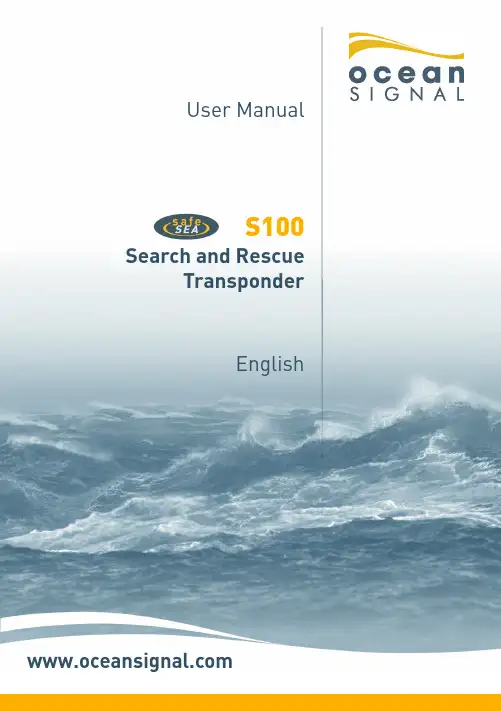
User ManualEnglishSearch and RescueTransponderS100© 2022 Ocean Signal LtdThe technical data, information and illustrations contained in this manual were believed to be correct at the time of print. Ocean Signal Ltd reserve the right to change specifications and other information contained in this manual as part of our continual improvement process.No part of this manual may be reproduced, stored in a retrieval system or transmitted in any form, electronic or otherwise, without the prior and express written permission of Ocean Signal Ltd.No liability can be accepted for any inaccuracies or omissions in this manual.Ocean Signal® and safeSEA® are registered trademarks of Ocean Signal Ltd.14/06/2022912S-00678 v01.203IN CASE OF EMERGENCY• REMOVE THE SART FROM ITS MOUNTING OR HOUSING • ACTIVATE THE SART:• TETHER THE SART TO THE LIFE RAFTUSING THE LANYARD TO AVOID IT BEING LOST OVERBOARD.FOR MAXIMUM EFFECTIVENESS, THE SART NEEDS TO BE MOUNTED AT LEAST 1 METER ABOVE THE SEA.• THE SART MAY BE ATTACHED TO THEROOF OF THE LIFE RAFT USING THE TIE PROVIDED IN THE LIFE RAFT. ALTERNATIVELY THE SART MAY BE MOUNTED ON THE TELESCOPIC POLE SUPPLIED AND ATTACHED TO THE SIDE OF THE LIFE RAFT.NOTE: Refer to section 4.3 for deactivation instructions 1. Break off the protective cover2. Slide and hold the Green switch to the left,then slide the Red switch into the down position and release the Green switch4 912S-00678 v01.2014/06/2022CONTENTS1. GENERAL51.1 Exposure to RF Electromagnetic Energy 51.2 Warnings 52.S100 OVERVIEW63. INSTALLATION 74. O P ERATION84.1 Deploy m ent 84.2 Activation 94.3 Deactivation 104.4 Testing 105. BATTERIES115.1 Battery Replacement126. A P P ENDIX 136.1 Maintenance and Troubleshooting 136.2 Accessories 136.3 Specifications 136.4 Approvals 146.5 Limited Warranty1414/06/2022 912S-00678 v01.20 51.GENERAL1.1 Exposure to RF Electromagnetic EnergyThis product has been evaluated for compliance with the FCC RF exposure limits given in CFR 47 part 2.1093 at a distance of 2.5cm for “Occupational Use Only”1.2 Warnings!Always operate the SART with any part of the device at least 6cm (2.4in) away from your body.!The SafeSEA S100 SART is designed for use in emergency only. Only operate it in situations of grave and imminent danger.!The SafeSEA S100 SART incorporates a protective tab over the operating controls to avoid accidental activation and indicate that the unit has been used.!After any period of operation, the battery should be replaced and the unit returned to your local service dealer for replacement of the protective tab. !Always replace the battery before the expiry date is exceeded to ensure full operating capacity in case of emergency.!Please ensure you follow local regulations before disposing of this item. Ensure the battery is removed from the unit before disposal.6 912S-00678 v01.2014/06/20222.S100 OVERVIEW1. Telescopic Mounting Pole2. Lanyard Attachment Point3. Test Switch4. Indicator LED5. Pole Attachment Point6. Interlock Switch7. Activation Switch8. Tear off tag9. Battery compartment in base14/06/2022 912S-00678 v01.20 73.INSTALLATIONThe S100 is supplied with a quick release mounting bracket. This bracket should bemounted on a suitable wall or bulkhead in a position where it can easily be retrieved in an emergency.Although the S100 is rugged and waterproof, Ocean Signal recommends mounting the SART in a protected position whenever possible.!Do not mount the SART closer than 1 meter to any steering compass as this may affect the accuracy of the compass.!Keep the S100 away from any strong magnetic sources such as loudspeak-ers, compass compensation magnets, etc.Mark the location of the four screw holes onto the mounting position. Pre-drill the holes if required then screw the mounting bracket to the surface using the four No6 x 5/8” screws supplied.The SART simply clips onto the mounting bracket.84.OPERATION4.1 Deploymentof 1 meter above sea level.er.!lost overboard.on them.14/06/2022912S-00678 v01.209Raise the SART vertically and attach the pole to the life raft. Most life rafts are fitted with suitable attachments to accommodate the SART pole.Alternatively, the SART may be attached directly to the life raft canopy.4.2 Activation!The SART should only be activated if there is grave and imminent danger to the vessel and its crew.To activate the SART, remove the unit from its mounting bracket.Break off the clear protective cover over the Green and Red switches.Holding the Green switch to the left, push the Red switch down and hold.While holding the Red switch down, release the Green switch to lock the Red switch in the active position.During operation, the Red LED next to the Test switch will flash once every 2-3 seconds to indi-cate the SART is operational:When activated by a received radar pulse the Red LED will start flashing rapidly:10912S-00678 v01.2014/06/20224.3 DeactivationIf the SART has been inadvertently activated, it can be turned off simply by reversing the activation process.Slide the Green switch to the left - the Red switch will return to the off position.Release the Green switch.It is not possible for the user to replace the clear protective cover . Return the SART to an Ocean Sig-nal authorised service centre for replacement.4.4 TestingIt is recommended that the S100 SART is tested periodically. A full test should be carried out in conjunction with an X-band radar on a nearby vessel if possible. A full test should always becarried out as part of the annual service, with short inspections every two months.Activate Test Mode by rotating the grey test switch clockwise and holding.If there is radar activity in the area then the Red LED will start to flash intermittently, indicating that the radar signals are being received.The radar display of any vessels within radar de-tection range of your location will now be showing the return from the SART.Depending on the distance of the vessel to the SART and the tuning of the radar , the display will vary between a set of concentric rings to a line of twelve blips in a straight line on a bearing between the vessel and the SART.!Test Mode is the same as Activation Mode, so keep the test duration to a minimum to avoid falsely alerting other vessels that you may be indistress and minimise battery drain.14/06/2022 912S-00678 v01.20 115. BATTERIESThe S100 SART uses a Lithium Iron Disulfide battery pack to power the device. These bat-teries have a five year storage life before any significant reduction in capacity. Each battery is marked with an expiry date, which is located at the base of the unit.! The battery should be replaced before the expiry date has passed to ensure reliable operation and full capacity in emergency situations.! Always use batteries manufactured by Ocean Signal. Failure to do so will in-validate the type approval and may mean the unit does not operate correctly in a distress situation.! Never dispose of batteries in a fire.! Never puncture or attempt to dismantle the battery.! Never attempt to charge the battery.! Extreme temperature caused by failure to observe the above warnings may cause the battery to explode or catch fire, which may result in injury or damage to surrounding personnel or property.!Dispose of used batteries in a responsible manner. National or local reg-ulations on battery disposal may apply including restricting the disposal of batteries in domestic refuse. For the Product Safety Data Sheet and advice on battery transportation, please see the Ocean Signal web site at .12 912S-00678 v01.2014/06/20225.1 Battery ReplacementThe battery may be changed by the user , although commercial vessels may be subject to local regulations relating to Shore Based Maintenance that prevent this.Remove the SART from its mounting bracket and turn it over .screw.Undo the screw using the 3mm Allen (Hex) key provided.Remove the pack from the main body.Insert new battery pack, ensuring that the rub-ber seal is correctly in position and the pack is pushed home fully. Tighten screw.Ensure that any maintenance records on-boardare updated with the new battery expiry date.14/06/2022 912S-00678 v01.20 136. APPENDIX6.1 Maintenance and TroubleshootingThe S100 SART should not need servicing during its lifetime, with the exception of changing the battery before the marked expiry date.Regular cleaning, inspection and testing are advised - clean any grime or salt residue off the unit with a weak solution of detergent in warm water . Never use solvents as this may affect the structural integrity of the plastics used. Rinse well with fresh water after clean-ing.Inspect the unit for signs of case damage or cracks, check the labels are intact and the battery is within the expiry date. Make sure the telescopic pole (if provided) is still present and is free to extend.Check for correct SART operation using the Test Mode (see section 4.4). If the unit appears to fail testing, check the following points before contacting a service representative:! Are there any vessels in the vicinity that would have an active radar system to trigger the SART?!Is the SART being shielded from being radar visible to other vessels? 6.2 AccessoriesReplacement Lithium Battery for S100 LB3S Ocean Signal Part Number 711S-0060914 912S-00678 v01.2014/06/20226.3 SpecificationsTransmitter Frequency 9.2-9.5GHz Output Power (EIRP) >400mW Number of sweeps/per interrogation 12Supply Battery Lithium Iron Disulfide (LiFeS2)Operating life (standby/active)96/12 hours at -20°CTest Standards IEC61097-2, IEC60945,Environmental IEC60945 Category Portable Temperature Range (operating) -20°C to +55°C Temperature Range (storage) -30°C to +65°C Waterproof 10 meters Drop proof (on water) 20 meters Compass safe distance 1 meter 6.4 ApprovalsThe SafeSEA S100 SART is approved under the EU Marine Equipment Directive under MED/4.18 of the current implementing regulation. The Declaration of Conformity can be downloaded from: /products/S100The SafeSEA S100 SART is approved in the UK under MSN 1874 (Amendment 5 M+F))The SafeSEA S100 SART complies with the GMDSS provisions of part 80 of the FCC rules.14/06/2022 912S-00678 v01.20 156.5 Limited WarrantyYour SafeSEA S100 SART is warranted against manufacturing defects in materials and workmanship for a period of two years from date of purchase. Ocean Signal Ltd will, at its discretion, repair or replace a faulty product free of charge, including return carriage costs to the owner.For further assistance, please contact our Technical Service Department: Email:********************Accidental damage and misuse or non-approved modifications are not covered by this war-ranty. This warranty does not affect your statutory rights.Dealer Stamp:Date of Purchase:Ocean Signal Ltd. Unit 4, Ocivan Way MargateCT9 4NNUnited Kingdom******************** 。
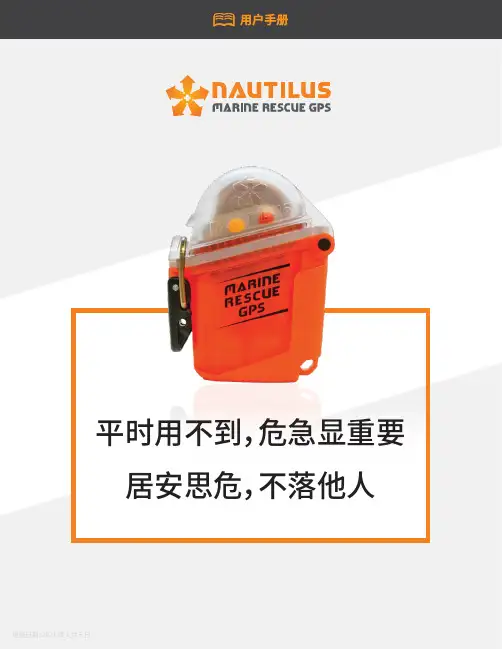
平时用不到,危急显重要快速入门指南注意事项Nautilus GPS部件地区设定与水上行动业务识别码操作Nautilus GPS应用程序测试程序电池信息天线卷线器03040506070809位置建议程序10 1111技术规格12目录2134松开锁扣,打开防水盖。
用力按下蓝色按钮,直到听到咔哒声。
打开Nautilus GPS电源,开始搜索GPS锁。
*拆下天线固定器,展开天线。
**按住红色按钮�秒,开始发出遇险信号Nautilus海上救援GPS只是安全辅助设备,并非救生设备,无法挽救生命。
**请按照标签提示拆卸固定器。
请小心拆卸天线固定器。
天线可能会迅速弹出。
*必须安装两节CR��� �V锂电池才能操作Nautilus GPS。
请注意!请确保您将Nautilus GPS放在正确区域。
详情请参阅第�页。
确保O型圈清洁,不受污染。
测试会缩短电池寿命,每次潜水前测试一次即可。
本设备仅为紧急情况下使用,非紧急情况时请勿使用。
防水盖应保持密封状态,除非遇险或自检时才能打开。
在某些国家,DSC功能可能因法规要求无法使用。
更换螺丝时,请勿用力过度。
拧螺丝时,稍有阻力即可。
Nautilus GPS使用CR��� �V (���� mAh)电池。
请勿在水下打开防水盖。
请小心拆卸天线固定器。
天线可能会迅速弹出。
如意外激活遇险信号,用户应尽快停止发送Nautilus GPS遇险信号,并尽早通知相关搜救机构,如美国海岸警卫队或该地区域的救援协调中心。
Nautilus海上救援GPS只是安全辅助设备,并非救生设备,无法挽救生命。
为符合CE射频暴露规定,确保Nauti-lus GPS在离身体至少��厘米范围内发射信号。
Nautilus GPS部件天线卷线器用力按下蓝色按钮,直到听到咔哒声:打开Nautilus GPS电源至待机模式(蓝色LED指示灯每秒闪烁一次),GPS进入锁定模式。
再次按下蓝色按钮,关闭Nautilus GPS电源。
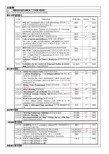
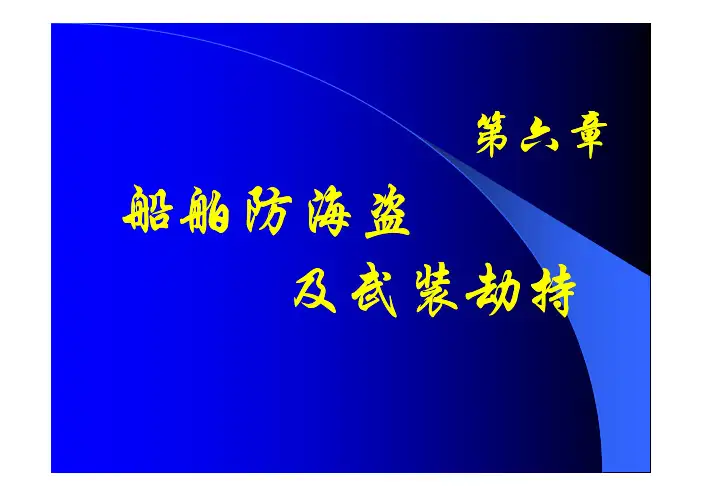
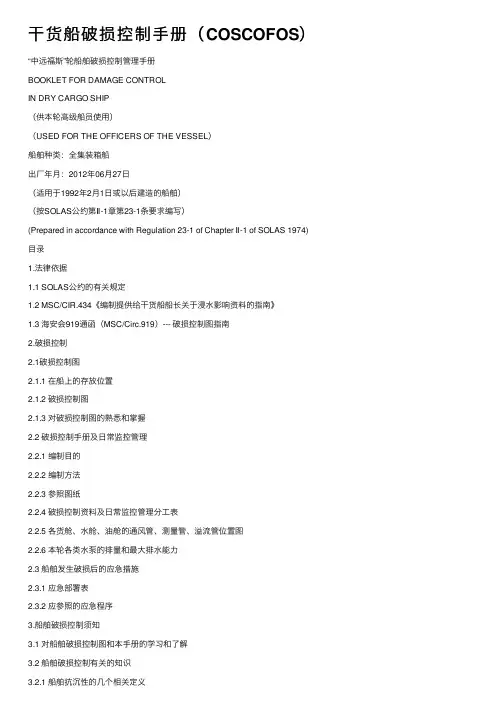
⼲货船破损控制⼿册(COSCOFOS)“中远福斯”轮船舶破损控制管理⼿册BOOKLET FOR DAMAGE CONTROLIN DRY CARGO SHIP(供本轮⾼级船员使⽤)(USED FOR THE OFFICERS OF THE VESSEL)船舶种类:全集装箱船出⼚年⽉:2012年06⽉27⽇(适⽤于1992年2⽉1⽇或以后建造的船舶)(按SOLAS公约第Ⅱ-1章第23-1条要求编写)(Prepared in accordance with Regulation 23-1 of Chapter Ⅱ-1 of SOLAS 1974)⽬录1.法律依据1.1 SOLAS公约的有关规定1.2 MSC/CIR.434《编制提供给⼲货船船长关于浸⽔影响资料的指南》1.3 海安会919通函(MSC/Circ.919)--- 破损控制图指南2.破损控制2.1破损控制图2.1.1 在船上的存放位置2.1.2 破损控制图2.1.3 对破损控制图的熟悉和掌握2.2 破损控制⼿册及⽇常监控管理2.2.1 编制⽬的2.2.2 编制⽅法2.2.3 参照图纸2.2.4 破损控制资料及⽇常监控管理分⼯表2.2.5 各货舱、⽔舱、油舱的通风管、测量管、溢流管位置图2.2.6 本轮各类⽔泵的排量和最⼤排⽔能⼒2.3 船舶发⽣破损后的应急措施2.3.1 应急部署表2.3.2 应参照的应急程序3.船舶破损控制须知3.1 对船舶破损控制图和本⼿册的学习和了解3.2.2 破舱稳性3.2.2.1 船舶进⽔类型3.2.2.2 稳性资料3.2.2.3 可能有⽤的⼏个公式3.2.2.4 船长对船体破损风险的分析3.2.3 充分理解船舶完整稳性和破舱稳性的要求3.2.3.1船舶完整稳性规则3.2.3.2船舶破舱稳性规则3.3 评估船舶破损和处理的快速⽅法附录:相关法律依据1.SOLAS第Ⅱ--1章第23-1条“⼲货船破损控制”的第⼀款2.海安委434通函(MSC/CIR.434)《编制提供给⼲货船船长关于浸⽔影响资料的指南》3.海安委919通函(MSC/CIR.919)——破损控制图指南1.法律依据:1.1SOLAS公约的有关规定第Ⅱ-1章第23-1条⼲货船破损控制的第⼀款。
OCIMF-MEG4关于系泊断裂载荷计算摘要:船舶系泊设备,通常采用各大船级社推荐舾装数EN计算公式,然后根据舾装数表格进行选取。
然后根据推荐缆绳SWL参数,来确定系泊设备的载荷。
欧洲港务委员会(European Harbour Masters’ Committee)统计数据表明,95%的人身伤害事件是由绳索和钢丝引起的,其中的60%发生在系泊作业期间。
2010至2014年之间,澳大利亚海事局收到超过220起与系泊相关事故报告,其中22%造成人员伤亡。
关键词:OCIMF-MEG4;系泊断裂;载荷计算1概述为了减少人身伤亡,以人文本设计原则,故OCIMF-MEG4推出船舶设计系泊断裂载荷SD-MBL,依次作为系泊设备设计和选取主要依据。
注意,OCIMF属于石油组织联合协会,主要针对液货船。
15000化学品船要求按照最新MEG4要求来计算MBL,传统船级社舾装数仅供参考。
如表1所示表1传统船级社舾装数MBL是缆绳,系泊设备选取以及锚绞车设计重要参数,那么MEG4是如何定义和计算呢?下面就针对15000化学品船进行案例分析,根据此计算过程,让大家做一个初步了解,为以后深入打下基础,最好能建立计算机模型软件,更方便,更简洁。
MEG4定义水文和气象参数,1,60节风速从任何一个角度吹过船舶;2,水流3节,角度0°/180°;3,水流2节,角度10°/170°;4,水流0.75节垂直船舶方向。
船舶是达到夏季载重线满载状况下,码头水深W与吃水T比值1.05。
下面是具体针对15000化学品船计算过程。
如表1.2.3所示表1船舶主要设计参数总长Loa(m)垂线长Lpp(m)型宽B(m)吃水D(m)AL(m2)AT(m2)147144.311.8.714104170风速60节,1节=0.514m/s, 60节=60*0.514=30.84m/s;表2标准情况下水文气象参数水流角度0°10°60°90°170°180°流速Vc(m/s)1.5421.028.5140.38551.0281.542表3码头与船舶吃水W/T船况Wd/T装载情况下1.05压载情况下32说明海水密度ρC =1.025Kg/m3 ,空气密度ρW=1.28Kg/m3,风向及水流方向从尾向首逆时针具体定义见下图1。
厦门机场FOD 防范宣传手册厦门机场FOD 管理办公室编制2016 年第一版目录一、什么是FOD二、FOD 有哪些危害三、机场有哪些典型的FOD四、机场不同区域的FOD 危险等级五、如何防范FOD六、倡议一.什么是FODFOD(Foreign Object Debris),即可能损伤航空器的某种外来的物质、碎屑或物体,如金属零件、防水塑料布、碎石块、纸屑、树叶等,以上统称外来物。
从扎伤轮胎上收集到的金属碎片二.FOD 有哪些危害航空器对于外来物来说相当脆弱,一小块塑料布被吸入发动机可能引起空停,一个小螺钉或金属片甚至尖锐石子将会扎伤轮胎引起爆胎,产生的轮胎碎片又会打伤飞机本体或重要部件,如液压管、油箱等。
被外来物扎伤的轮胎据保守估计,每年全球因FOD 造成的损失至少30-40 亿美元,我国民航每年约发生4500 多起FOD 损伤轮胎事件。
一向不被人注意的场内外来物,有可能损坏航空器发动机、轮胎等重要部件,造成巨大的经济损失,酿成安全事故,后果不堪设想。
被外来物损伤的发动机叶片被外来物损伤的机翼2000 年7 月25 日,法国航空公司一架协和超音速客机,在从巴黎戴高乐机场起飞后56 秒失事坠毁,造成机上109 人全部遇难、地面4 人死亡的严重事故。
协和飞机协和飞机油箱起火失事原因是飞机在起飞滑跑过程中压到了跑道上一块43 厘米长的金属薄片,致使轮胎爆裂,爆裂的轮胎碎片击中了飞机油箱,引发燃油泄漏并起火,导致飞机坠毁。
扎破协和飞机轮胎的金属碎片协和飞机事故残骸2007 年6 月29 日,国内一架B747 飞机在美国洛杉矶机场滑行中压到地面上的外来物造成轮胎损伤,导致在随后的起飞滑跑中右起落架后面两个轮胎爆裂,造成飞机右机身下半部、右起落架、起落架舱、液压系统管路等严重损坏。
两个主轮爆裂后轮胎和轮毂损伤形貌损坏严重的起落架2006 年12 月8 日,国内一架B747 飞机在芝加哥机场降落滑跑过程中遭外来物损伤,导致 4 号发动机17 片叶片遭到不同程度的损伤,进气道整流罩内侧部分被打坏。
船上可利用的防海盗设备和工具
1.降落伞火箭信号及信号发射枪等,可阻吓海盗。
2.橙色烟雾信号,可用来干扰海盗视线。
3.抛缆器。
4.太平斧,可用来砍断海盗攀爬的缆索,面对持冷
兵器海盗时可作自卫工具使用。
5.灭火器,可用于自卫和驱赶海盗。
6.警报器,用于报警,阻吓海盗。
7.钩镰枪,可用来解除海盗登船的绳钩。
8.铁棍,用于自卫。
9.高压皮龙。
10.石灰
11.汽油
12.防弹衣、迷彩服、钢盔
13.强光手电、大功率激光手电、手提式探照灯—
—可以有效干扰海盗视线。
14.电警棍
15.手铐
16.对讲机
17.超高功率喇叭,通过噪音阻止海盗接近。
18.超滑泡沫,增加海盗攀爬和行走的难度。
19.声光爆炸弹—一种可以在船上专用发射器点燃发射并可发出巨大响声和亮光同时伴有烟雾的非伤人性的烟花爆炸性物品。
【新奇】9种新奇防海盗设备当前形势下,索马里海盗存在的根源问题尚未能有效消除,战舰护航在不断创新袭击手段和拓展作战区域的海盗面前又稍显力不从心,而绕道航行则将大幅增加航行时间与营运成本。
因此,船公司和船员惟有加强防范意识并采取有效预警与自卫措施,才能降低被海盗袭击的风险。
以下介绍一些防海盗的一些新型设备及研究进展。
1. 船舶“防盗门”大连中远船务首次承接并圆满完成了中远系统“南海”和“晶莹海”两艘船的防海盗门改造任务。
防海盗关键是船上要有一个封闭空间,并为这个空间加上一个“防盗门”和通风、通讯设施,一旦紧急情况发生,船员只要进入该空间,关上“防盗门”,海盗就对其无可奈何了。
大连中远船务在接到工程后,立足于船舶实际,因地制宜改造,不仅节约资金,而且更符合实船状况。
2.高压电网为了应对春季海盗高发的情况,国内主要的航运公司组织技术人员对旗下航行于亚丁湾航线的船舶进行了高压电网安装调试工作。
外高桥边检站民警告诉记者,防海盗电网的运行电压高达5000伏特,能使攀爬货轮的海盗即刻晕厥,但不危害其生命。
在船舶驶入海盗预警海域前,船员需对防海盗电网进行安装;使用时,船员将电网在甲板左右两舷张开后接通甲板电源;驶离预警海域后,将电网拆除并放入仓库,以保障船舶入港安全。
巴拿马籍“锡伯河”轮靠泊上海外高桥港,该轮作为沪上第一艘配置防海盗电网装置的集装箱轮,顺利完成了电网安装后的首次亚丁湾航线任务。
“锡伯河”轮是在今年新年靠泊外高桥码头期间安装电网的。
3.激光耀眼系统为了防止海盗袭击商船,总部设在英国的BAE系统公司最近已经推出了一种新型激光耀眼系统。
据英国媒体报道,该系统既可以使远在1000码的海盗失去攻击能力,又不会使其受到永久性的伤害。
据英国《每日电讯报》报道,在伦敦国际防御系统和设备展览会上展出的其他打击海盗袭击设备为可以发现15英里远的小船的雷达和通过遥控关闭船舶发动机的装置。
4. 遥控水炮今年1月26日至27日,瑞典AB公司的Unifire反海盗水炮炫打击海盗会议在新加坡举行,展示了其先进的,令人印象深刻的不锈钢制,高压力,遥控水炮(图1)。
OceanGuard TM Operations & Maintenance ManualTable of ContentsIntroduction (2)Why do I need to perform maintenance? (2)Health and Safety (3)Personnel health and safety (3)How does it Work? (4)Maintenance Procedures (4)Primary Types of Maintenance (4)Minor Service (5)Hand Maintenance (5)Vacuum Maintenance (5)Major Service (Filter Bag Replacement) (5)Additional Reasons of Maintenance (6)Hazardous Material Spill (6)Blockages (6)Major Storms and Flooding (6)Disposal of Waste Materials (6)Maintenance Services (6)Rev: 1 Last Updated: March 2019IntroductionThe primary purpose of stormwater treatment devices is to capture and prevent pollutants from entering waterways, maintenance is a critical component of ensuring the ongoing effectiveness of this process. The specific requirements and frequency for maintenance depends on the treatment device and pollutant load characteristics of each site. This manual has been designed to provide details on the cleaning and maintenance processes as recommended by the manufacturer.The OceanGuard technology is a gully pit basket designed to fit within new and existing gully pits to remove pollution from stormwater runoff. The system has a choice of Filtration liners, designed to remove gross pollutants, total suspended solids and attached pollutants as either a standalone technology or as part of a treatment train with our StormFilter or Jellyfish Filtration products. OceanGuard pit baskets are highly effective, easy to install and simple to maintain.Why do I need to perform maintenance?Adhering to the maintenance schedule of each stormwater treatment device is essential to ensuring that it functions properly throughout its design life.During each inspection and clean, details of the mass, volume and type of material that has been collected by the device should be recorded. This data will assist with the revision of future management plans and help determine maintenance interval frequency. It is also essential that qualified and experienced personnel carry out all maintenance (including inspections, recording and reporting) in a systematic manner. Maintenance of your stormwater management system is essential to ensuring ongoing at-source control of stormwater pollution. Maintenance also helps prevent structural failures (e.g. prevents blocked outlets) and aesthetic failures (e.g. debris build up), but most of all ensures the long term effective operation of the OceanGuard.Health and SafetyAccess to pits containing an OceanGuard typically requires removing (heavy) access covers/grates, but typically it is not necessary to enter into a confined space. Pollutants collected by the OceanGuard will vary depending on the nature of your site. There is potential for these materials to be harmful. For example, sediments may contain heavy metals, carcinogenic substances or sharp objects such as broken glass and syringes. For these reasons, there should be no primary contact with the waste collect and all aspects of maintaining and cleaning your OceanGuard require careful adherence to Occupational Health and Safety (OH&S) guidelines.It is important to note that the same level of care needs to be taken to ensure the safety of non-work personnel, as a result it may be necessary to employ traffic/pedestrian control measures when the device is situated in, or near areas with high vehicular/pedestrian activity.Personnel health and safetyWhilst performing maintenance on the OceanGuard pit insert, precautions should be taken in order to minimise (or when possible prevent) contact with sediment and other captured pollutants by maintenance personnel. In order to achieve this the following personal protective equipment (PPE) is recommended: ∙Puncture resistant gloves∙Steel capped safety boots,∙Long sleeve clothing, overalls or similar skin protection∙Eye protection∙High visibility clothing or vestDuring maintenance activities it may be necessary to implement traffic control measures. Ocean Protect recommend that a separate site specific traffic control plan is implemented as required to meet the relevant governing authority guidelines.The OceanGuard pit insert is designed to be maintained from surface level, without the need to enter the pit. However depending on the installation configuration, location and site specific maintenance requirements it may be necessary to enter a confined space occasionally. It is recommended that all maintenance personnel evaluate their own needs for confined space entry and compliance with relevant industry regulations and guidelines. Ocean Protect maintenance personnel are fully trained and carry certification for confined space entry.How does it Work?OceanGuard is designed to intercept stormwater as it enters the stormwater pits throughout a site. The OceanGuard has diversion panels that sit flush with the pit walls, this ensures that as stormwater enters at the top of the pit it is directed to the middle of the insert where the Filtration bag is situated. The filtration bag allows for screening to occur removing 100% of pollutants greater than the opening of the filtration material (200micron, 1600micron bags available).During larger rain events the large flows overflow slots in the flow diverter of the OceanGuard ensure that the conveyance of stormwater is not impeded thus eliminating the potential for surface flooding. As the flow subsides, the captured pollutants are held in the OceanGuard Filtration bag dry. The waste then starts to dry which reduces the magnitude of organic material decomposition transitioning between maintenance intervals.Maintenance ProceduresTo ensure that each OceanGuard pit insert achieves optimal performance, it is advisable that regular maintenance is performed. Typically the OceanGuard requires 2-4 minor services annually, pending the outcome of these inspections additional maintenance servicing may be required.Primary Types of MaintenanceThe table below outlines the primary types of maintenance activities that typically take place as part of an ongoing maintenance schedule for the OceanGuard.Description of Typical Activities FrequencyMinor Service Filter bag inspection and evaluationRemoval of capture pollutantsDisposal of material2-4 Times AnnuallyMajor ServiceFilter Bag ReplacementSupport frame rectificationAs requiredMaintenance requirements and frequencies are dependent on the pollutant load characteristics of each site. The frequencies provided in this document represent what the manufacturer considers to be best practice to ensure the continuing operation of the device is in line with the original design specification.Minor ServiceThis service is designed to return the OceanGuard device back to optimal operating performance. This type of service can be undertaken either by hand or with the assistance of a Vacuum unit.Hand Maintenance1.Establish a safe working area around the pit insert2.Remove access cover/gratee two lifting hooks to remove the filtration bag4.Empty the contents of the filtration bag into a disposal container5.Inspect and evaluate the filtration bag6.Inspect and evaluate remaining OceanGuard components(i.e. flow diverter, filtration cage and supporting frame)7.Rejuvenate filtration bag by removing pollutant build up with a stiff brush, additionally the filtrationbag can be washed using high pressure water8.Re-install filtration bag and replace access cover/grateVacuum Maintenance1.Establish a safe working area around the pit insert2.Remove access cover/grate3.Vacuum captured pollutants from the filtration bag4.Remove filtration bag5.Inspect and evaluate the filtration bag6.Inspect and evaluate remaining OceanGuard components(i.e. flow diverter, filtration cage and supporting frame)7.Rejuvenate filtration bag by removing pollutant build up with a stiff brush, additionally the filtrationbag can be washed using high pressure water8.Re-install filtration bag and replace access cover/grateMajor Service (Filter Bag Replacement)For the OceanGuard system, a major service is a reactionary process based on the outcomes from the minor service.Trigger Event from Minor Service Maintenance ActionFiltration bag inspection revealsdamageReplace the filtration bag[1]Component inspection reveals damage Perform rectification works and if necessary replace components[1][1] Replacement filtration bags and components are available for purchase from Ocean Protect.Additional Reasons of MaintenanceOccasionally, events on site can make it necessary to perform additional maintenance to ensure the continuing performance of the device.Hazardous Material SpillIf there is a spill event on site, all OceanGuard pits that potentially received flow should be inspected and cleaned. Specifically all captured pollutants from within the filtration bag should be removed and disposed in accordance with any additional requirements that may relate to the type of spill event. All filtration bags should be rejuvenated (replaced if required) and re-installed.BlockagesThe OceanGuards internal high flow bypass functionality is designed to minimise the potential of blockages/flooding. In the unlikely event that flooding occurs around the stormwater pit the following steps should be undertaken to assist in diagnosing the issue and implementing the appropriate response.1.Inspect the OceanGuard flow diverter, ensuring that they are free of debris and pollutants2.Perform a minor service on the OceanGuard3.Remove the OceanGuard insert to access the pit and inspect both the inlet and outlet pipes, ensuringthey are free of debris and pollutantsMajor Storms and FloodingIn addition to the scheduled activities, it is important to inspect the condition of the OceanGuard pit insert after a major storm event. The inspection should focus on checking for damage and higher than normal sediment accumulation that may result from localised erosion. Where necessary damaged components should be replaced and accumulated pollutants disposed.Disposal of Waste MaterialsThe accumulated pollutants found in the OceanGuard must be handled and disposed of in a manner that is in accordance with all applicable waste disposal regulations. When scheduling maintenance, consideration must be made for the disposal of solid and liquid wastes. If the filtration bag has been contaminated with any unusual substance, there may be additional special handling and disposal methods required to comply with relevant government/authority/industry regulations.Maintenance ServicesWith over a decade and a half of maintenance experience Ocean Protect has developed a systematic approach to inspecting, cleaning and maintaining a wide variety of stormwater treatment devices. Our fully trained and professional staff are familiar with the characteristics of each type of system, and the processes required to ensure its optimal performance.Ocean Protect has several stormwater maintenance service options available to help ensure that your stormwater device functions properly throughout its design life. In the case of our OceanGuard system we offer long term pay-as-you-go contracts, pre-paid once off servicing and replacement filter bags.For more information please visit .au。